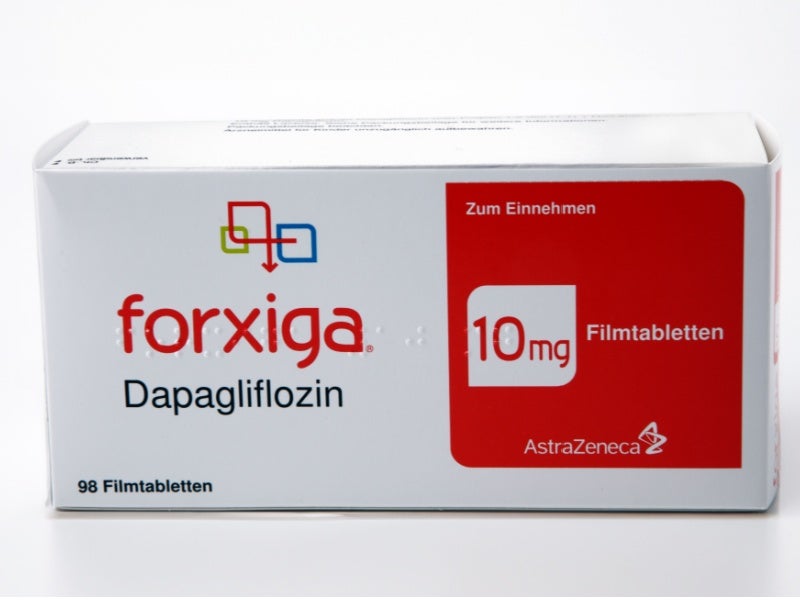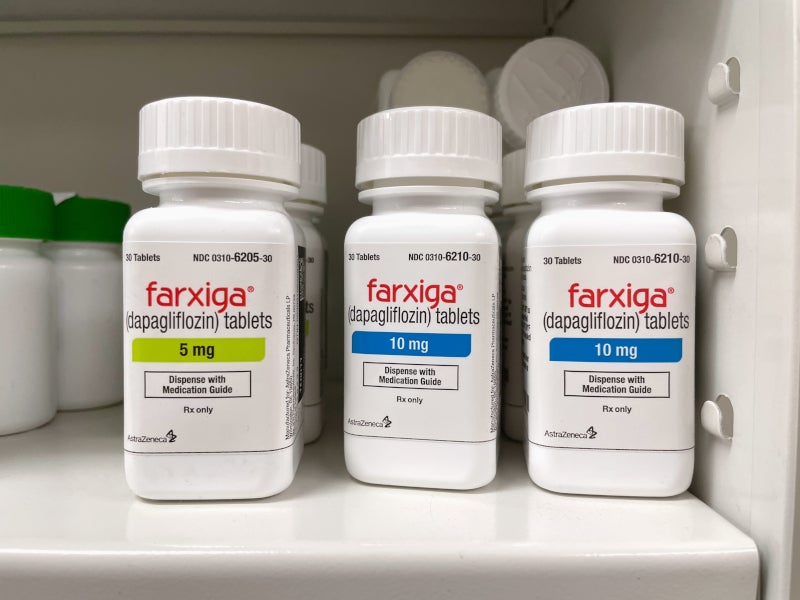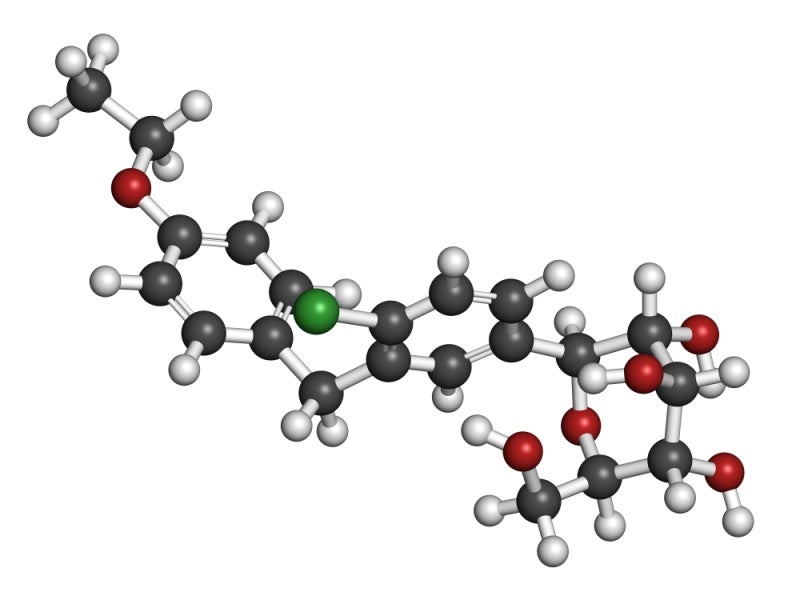Forxiga® (dapagliflozin) is a first-in-class, oral, once-daily sodium-glucose co-transporter 2 (SGLT2) inhibitor indicated for the treatment of type 2 diabetes (T2D), chronic heart failure (HF) and chronic kidney disease (CKD).
Jointly developed by AstraZeneca and Bristol-Myers Squibb (BMS), the drug is marketed under the brand name Farxiga® in the US.
The drug is available as yellow, biconvex, film-coated tablets in round-shaped 5mg and diamond-shaped 10mg doses.
Regulatory approvals for Forxiga
In November 2012, Forxiga was granted marketing approval by the European Commission (EC) for the treatment of T2D in Europe.
AstraZeneca and BMS received approval from the US Food and Drug Administration (FDA) for dapagliflozin as a once-daily oral treatment for adults with T2D mellitus in January 2014.
The FDA approved the drug to reduce the risk of kidney function decline, kidney failure, cardiovascular death and hospitalisation for HF in adults with CKD who are at risk of disease progression in April 2021.
Subsequently, the drug was approved in the European Union (EU) to treat adults with CKD with and without T2D in August 2021, based on results from the DAPA-CKD Phase III trial.
In February 2023, the EC extended the indication for HF with reduced ejection fraction (HFrEF), which includes patients with mildly reduced and preserved ejection fraction (HFmrEF, HFpEF), as well as individuals throughout the whole spectrum of left ventricular ejection fraction (LVEF).
The approval was based on the positive results from the Phase III DELIVER clinical trial.
In May 2023, the FDA extended the indication to reduce the risk of cardiovascular death, hospitalisation for heart failure (hHF), and urgent HF visits in adults with HF. The results from a pre-specified, pooled analysis of the DAPA-HF and DELIVER Phase III trials supported the approval.
The National Medical Products Administration (NMPA) of China approved dapagliflozin for the treatment of symptomatic chronic HF in adults in August 2023.
Farxiga is approved in 126 as an adjunct to diet and exercise to improve glycaemic control in adults with T2D. It is approved for the treatment of HF and CKD in adult patients in more than 100 countries worldwide.
In June 2024, the FDA extended the drug label to improve glycaemic control in paediatric patients with T2D in children aged ten years and older, based on positive results from the paediatric T2NOW Phase III trial.
Forxiga is approved for paediatric patients aged ten and above with T2D in 56 countries, including the EU and other regions, based on results from the T2GO Phase III clinical trial.
Type 2 diabetes causes and symptoms
T2D is a metabolic disorder characterised by high levels of sugar in the blood. The symptoms of the disease include frequent urination, constant appetite and excess thirst. These symptoms are found in approximately 85% to 95% of adult patients diagnosed with diabetes.
Diabetes prevalence is expected to reach 783 million by 2045, with T2D accounting for more than 90% of all diabetes worldwide, yet significant unmet medical needs persist due to poor blood sugar control and low medication adherence.
Also known as kidney failure, CKD is a gradual loss of kidney function, leading to dangerous fluid, electrolyte, and waste accumulation. Symptoms include nausea, vomiting, fatigue, sleep problems, decreased mental sharpness, muscle cramps, swelling, high blood pressure, and chest pain.
HF occurs when the heart muscle fails to pump blood properly, leading to shortness of breath and fluid buildup in the lungs. Symptoms include shortness of breath, fatigue, swelling, irregular heartbeat, reduced exercise ability, wheezing, belly swelling, rapid weight gain, nausea, lack of appetite, difficulty concentrating, and chest pain if caused by a heart attack.
Dapagliflozin’s mechanism of action
Dapagliflozin inhibits SGLT2 in the kidneys. The protein normally prevents glucose from being excreted in the urine. In individuals with diabetes, where blood glucose levels are elevated, dapagliflozin’s inhibition of SGLT2 facilitates increased glucose excretion via urine, thus lowering blood glucose levels.
Additionally, dapagliflozin has benefits for cardiac and renal health. It promotes the excretion of excess salt and water, leading to a reduction in blood volume. Consequently, this alleviates the workload on the heart, particularly benefiting those with chronic HF. Moreover, it aids kidney function in patients with CKD, with or without diabetes.
Clinical trials on Forxiga
The EU approval for Forxiga was based on the results from 11 Phase III clinical trials. The randomised, double-blind and placebo-controlled studies enrolled more than 5,693 patients with T2D internationally. The studies assessed the safety and efficacy of Forxiga in comparison with placebo. The subjects were administered 10mg of the drug once daily as oral therapy.
Phase III studies met the endpoint of achieving glycated haemoglobin (HbA1c) of less than 7%. The results also showed that Forxiga reduced body weight, as well as blood pressure. The adverse events found during the clinical studies included an increase in blood creatinine, nausea, rash and dizziness.
The FDA approval for Farxiga was based on monotherapy and combination studies. The studies evaluated Farxiga in combination with metformin, pioglitazone, glimepiride, sitagliptin, or insulin. It included a 24-week clinical study that enrolled 840 T2D patients. The results of the study demonstrated that patients treated with Farxiga 5mg or 10mg doses showed significant reductions in HbA1c of 0.7% and 0.8%, respectively when compared to placebo plus metformin which showed reductions of just 0.3%.
The combination treatment studies also showed that patients administered with Farxiga 10mg plus metformin XR witnessed statistically significant improvements in HbA1c and FPG compared to monotherapy treatments. A statistically significant reduction in body weight was also observed compared to metformin XR alone.
Other clinical trials on Forxiga
The drug achieved a positive result in the Phase III DECLARE-TIMI 58 clinical study, a large cardiovascular outcomes trial in which 17,000 patients with T2D were studied over a period of up to five years, across 33 countries.
The drug met the primary endpoint of a statistically significant reduction in hospitalisation for HF or CV death in a wide group of patient population. The safety profile was also well established.
The FDA approval of the drug for paediatric T2D patients was based on the results from the T2NOW Phase III trial. Participants were randomised to either dapagliflozin, saxagliptin, or a placebo.
The trial’s primary endpoint was to measure the variation in A1C levels- an average blood sugar marker, at 26 weeks compared to placebo, using either 5mg or 10mg of dapagliflozin or 2.5mg or 5mg of saxagliptin.
Dapagliflozin met the primary endpoint at week 26, indicating that it can significantly enhance glycaemic control in children and adolescents with T2D. Furthermore, the safety profile of Farxiga in this younger demographic paralleled the established safety data observed in adults with T2D.










